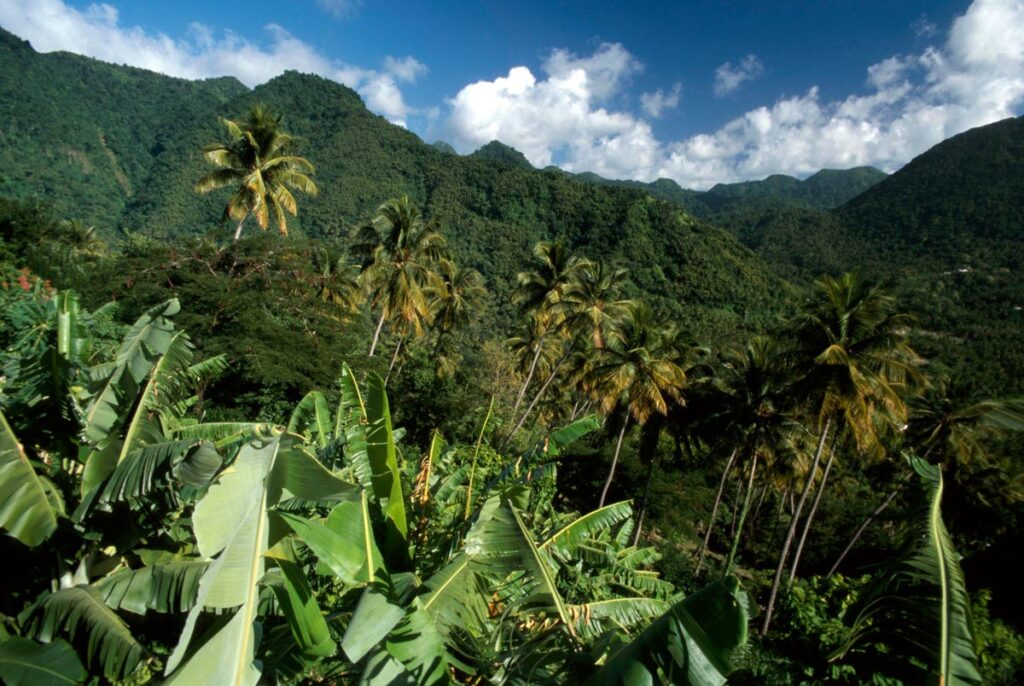Mount Gimie Range, St. Lucia. (Photo by: Jeffrey Greenberg/Universal Images Group via Getty Images)
St. Lucia may only be 27 miles long and 14 miles wide, but it boasts one of the world’s fastest women — Julien Alfred, the female version of Jamaica’s Usain Bolt. The country of roughly 180,000 people is also proud of its two Nobel Prize winners for literature and economics.
And while it may be the world’s top-rated honeymoon destination, St. Lucia is slipping off the global radar — a quiet victim of climate events that are wiping out its farm products and infrastructure. Tropical Storm Brett sucker punched it in June and has yet to recover. The Caribbean Island needs help, too, ironic because it is close to becoming a net carbon remover — a function of its rainforest preservation efforts.
Once colonized by the British and French, St. Lucia is part of the West Indies. The area is composed of Antigua, Barbuda, Bahamas, Barbados, Cuba, Dominica, Dominican Republic, Grenada, Haiti, Jamaica, Saint Kitts, Nevis, Saint Vincent, the Grenadines, Trinidad, and Tobago.
As the climate effects worsen, these countries will suffer more. Heavy rains often wash down the mountains, destroying homes, farmland, and transportation routes — events I witnessed last year in the Dominican Republic.
“We sustain our people and a wider population,” Leslie Jn Baptiste, legal and business management consultant, told me. “We have reserved a large portion of our trees and rainforests. If we can do this as a small island, the richer countries can do the same while recognizing the island nations for doing this. We are here to assist you — but we also need you to support and encourage us.”
The World Bank says St. Lucia has a gross domestic product per capita of more than $9,400 per year — too rich to qualify for international banking aid, yet too little to invest in climate adaptation and mitigation or things like building better bridges and roads. Meanwhile, diesel-powered generators comprise 99% of its electricity generation in a country with abundant sunshine.
To that end, it built a 3-megawatt solar farm in 2018, which serves 3,500 homes and offsets 3,800 metric tons of CO2 annually.
As the editor-at-large for the Coalition for Rainforest Nations, which represents 65 of these countries, I research and write about ways they can pursue and finance their commitments under the Paris Agreement.
Where’s the Help?
Tropical Storm Brett hits St. Lucia in June 2023
St. Lucia has dry and wet seasons. From November to May, it is dry and hot; from June to October, it is rainy, creating flooding conditions. But the weather has become erratic over the last five years — conditions with heavy downfalls and severe flooding year-round. Troughs or periods with weaker winds but heavy rains frequently create landslides as the water rushes off the mountainsides. Water levels quickly hit four feet within an hour.
“This never makes the international news,” says Jn Baptiste. But the impact is enormous, destroying the local crops such as bananas, lettuce, and tomatoes. “This lack of food affects everyone for months.” As for Tropical Storm Brett — heavier winds and less severe rains — destroyed the banana crop, which the island nation sent to the United Kingdom.
Altogether, eight tropical storms have hit the island in the last year. It’s a matter of time before the hurricane-strength winds rip through. In any event, climate change and warming oceans bleach the coral reefs and leave the beaches littered with sargassum, or ugly seaweed. That hurts fishermen, affects birds, and prevents sea life from breeding.
It is not about asking rich nations to pay less affluent ones for climate damages. Instead, it is about climate finance and mitigation — efforts to keep the rainforest standing to soak up atmospheric CO2 emissions. St. Lucia is almost carbon negative, according to the United Nations Framework Convention on Climate Change.
Between the 1970s and the 1990s, agriculture contributed to higher deforestation rates. Now, though, the focus is on tourism. The island has about 32,000 hectares of forests or 79,000 acres. About 25,000 hectares or 61,700 acres of that is nationally protected. Forests cover about 60% of the country — trees that sequester carbon, store water, and block hurricane winds.
There’s a bright spot on the horizon. Other nations may soon buy carbon offsets from St. Lucia. They could start trading “internationally transferred mitigation outcomes” or ITMOs next year — money to help them save their rainforests.
“We want the bigger emitters to see that the smaller islands are doing their part,” Rebecca Rock, deputy chief of the forest, told me. “We have done this ourselves and without international help. Hopefully, we will receive some international funding.”
The developed countries implicitly understand the need for climate finance. Yet, such funding remains elusive despite the urgency — made evident by the rash and severity of wildfires, storms, and extreme heat occurring globally.
The island countries are ground zero for hurricanes and tropical storms, which feed off atmospheric moisture and warmer oceans. And St. Lucia is a case in point — a country battered by a series of storms that threaten its fragile economy, especially its tourism sector. Climate adaptation is its top priority, requiring the world’s attention and assistance.
